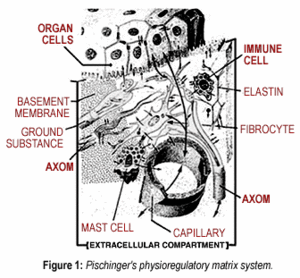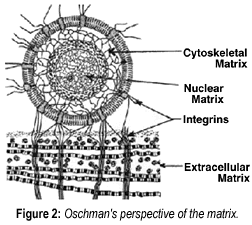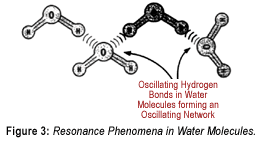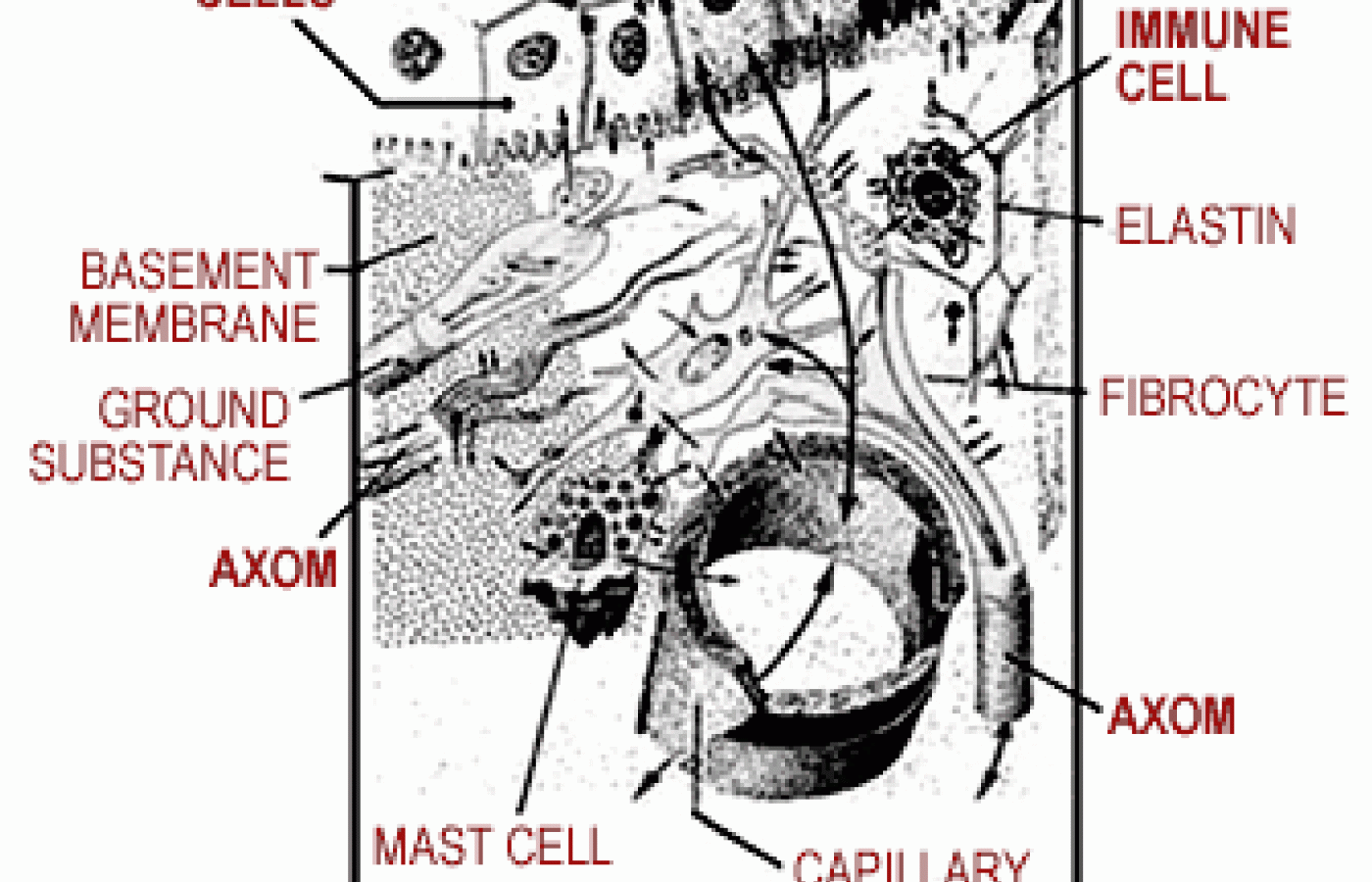Many relevant diagnostic signs are not performed deliberately by the examiner or by the patient at the examiner’s direction. They are observed as the patient reacts to their condition. Fortin’s finger sign, Minor’s sign, and Vanzetti’s sign are three examples of this principle.
Part V- Emerging Scientific Research Supports the "Self-Regulation Paradigm"
| This article presents some developments in science that support the alternative paradigm we advocate, as a countermeasure to the medical-drug cartel. Our objective is primarily to introduce the scope of the ongoing "research program" in this area of practice. The significance of this program will be further addressed in Part VI, relative to the subject of the philosophy of science. First, however, we will briefly review some points presented in our prior articles. |
Part I (www.chiroweb.com/archives/19/19/15.html): The "self-regulation" paradigm differs in part from that of conventional medicine because it focuses on the body's innate capacity for self-regulation, rather than on the cellular theory of disease. It also seeks to enhance and remove interference with the body's functional capacity by correcting physio-regulatory dysfunction, and by working with nature, rather than opposing disease and warring with nature.
Part II (www.chiroweb.com/archives/19/21/13.html): The "self-regulation" paradigm derives from Claude Bernard, the leading physiologist of the 19th century. We presented a copy of Dr. Bernard's 1860 lecture that outlined his milieu intérieur concept and its role in health and disease. Although he pointed to the significance of the circulatory system as an element of self-regulation, he also stated: "The nervous system, as Blainville philosophically observed, creates a secret harmony between the different parts of the living frame, establishes a permanent connection between them, and renders them mutually dependent upon each other."
We also briefly addressed the concept of the body's regulatory system as described by the early chiropractor Terrence Bennett. Part of Dr. Bennett's work (neurovascular reflexes) is still used by applied kinesiology practitioners. The greatest advances in the understanding of the body's innate capacity for self-regulation and health maintenance have, however, been made by the German naturopaths. We introduced the work of Alfred Pischinger relative to the "extracellular compartment." We will briefly expand upon Pischinger's model in this article. (See Figures 1 and 2.)
Part III (www.chiroweb.com/archives/20/03/16.html): As indicated in Part II, the German naturopaths have performed significant research with respect to the body's innate functional capacity and have developed several instruments to diagnose and treat problems related to the extracellular compartment. We described some of these instruments:
Diagnostics:
- Biological terrain analysis is used to evaluate the chemistry of the extracellular compartment ("physioregulatory matrix/system").
- Computed regulation thermography uses a thermocouple device similar to that used by B.J. Palmer. The instrument is used to evaluate thermal reaction within the physioregulatory matrix.
Diagnostics/Therapeutics:
- Matrix imaging is used to measure the electronic status of the physioregulatory matrix and to evaluate the body's response to medicines, nutraceuticals, etc. Thus, this type of instrument is both diagnostic and therapeutic.
Therapeutics:
- Matrix regeneration therapy is a modernized, electronic application of principles similar to the "cupping" used in traditional Chinese medicine. Generalized deposits and toxins are loosened and removed from within the physioregulatory matrix.
- Neural therapy incorporates saline (with perhaps lidocaine, etc.) injections, used to remove localized interferences within the physioregulatory matrix.
Part IV (www.chiroweb.com/archives/20/08/17.html): We took a slight detour to respond to an important question from a reader, asking what it is that defines a profession. Our unequivocal answer was "the law." We pointed out that the basis upon which the law accepts more than one healing arts profession is that the various professions use different paradigms: They start from different philosophical assumptions (we will return to this issue in Part VI), employ different pathophysiological models, and have developed different treatment protocols.
We will now address some of the emerging research supporting the physioregulatory paradigm. We suggest that all chiropractors read Inner Wisdom: The Challenge of Contextual Healing, by Dean Black,PhD. Dr. Black, a former professor at Parker Chiropractic College, presents a theory of environmental regulation of the intracellular function based primarily on chaos theory (slightly different from, but compatible with, our thesis).
Part V: Emerging Scientific Research
Anatomical Aspects
Pischinger developed his model of the physioregulatory matrix system (Figure 1) in the 1940s.1 As first conceived by Pischinger, intracellular regulation was performed by only the extracellular components (cf: Palmer and the nerves). However, as noted by the early chiropractor Terrence Bennett "...the arteriole, the capillary, the tissue space, the cell, the lymph capillary, which also lies is this same area, and we have a functional unit which is common to all tissue in the body." (Emphasis added.) The addition of the cell is critical and, as we shall see in a moment, the nucleus and DNA are also included in the "functional unit."

The book from which Figure 1 is adapted also addresses other functional components of the extracellular compartment, in addition to those shown in the image. Space does not permit us to describe those elements or their functional activity. It serves our purpose of demonstrating the scope of the physioregulatory research program to merely recite these additional components: glycosaminoglycans; proteoglycans (including dermatin sulfate, heparin sulfate, keratan sulfate); hyaluronic acid; structural glycoproteins; network-forming proteins; fibronectin; chondronectin; and sugars. Of course, the "ground substance" includes perhaps the most important factor - water. (See "Homeopathy" below.)
The names Palmer, Cleveland and Parker are recognized by all chiropractors as being names of families famous for their contributions to the chiropractic profession. We will add two more: Lief and Chaitow. Englishman Leon Chaitow,ND,DO, the author of Soft-Tissue Manipulation, A Practitioner's Guide to the Diagnosis and Treatment of Soft Tissue Dysfunction and Reflex Activity, is a descendant of Stanley Lief who, in the early 1900s, qualified as a chiropractor and naturopath in the United States. Dr. Lief, however, was in Britain at the outbreak of the First World War, and he and his descendants have practiced natural medicine in England ever since.
Chaitow's book is the best source we have found for the torso neurovascular points identified by the chiropractor Terrence Bennett (referred to above, more particularly in parts II and III of this series of articles). Through Chaitow's Journal of Bodywork and Movement Therapies (2000), James Oschman,PhD was commissioned to write a book covering recent advances in the scientific understanding of what he termed "energy medicine." He wrote from the limited perspective of the "bodyworker."2 This perspective is a valuable addition to the model of "regulatory" medicine but simply ignores the work of Pischinger and the German naturopaths. Dr. Oschman does, however, add some very valuable information relative to the concept of the "matrix."

Comparing the two-dimensional Figure 2 with Figure 1 shows an additional component - integrins. This is an extremely important addition to the understanding of the body's innate regulatory system. We will address the functional aspect of these components in a following section. (see Tensegrity). We will allow Oschman to express the anatomical aspects for us:
"A whole class of 'trans-membrane' linking molecules, or 'integrins,' has been discovered. Likewise, it is now recognized that the cytoplasmic matrix also links to the nuclear envelope, nuclear matrix and genes." (Oschman, pp. 45-46)Bennett had it right. The cell - and now we add the nucleus and genes - are part of the "functional unit." The cells and the genes are the primary focus of allopathic medicine. We suggest that the work done by the German naturopaths, and the diagnostic instruments and therapeutic protocols developed by them, needs further research; more importantly, the clinical applications need to be expanded. But who will do it? Who will "own" it? So far, the medical-drug cartel has resisted efforts to expand the "self-regulation" concept, and chiropractors have, in general, failed to recognize the significance of the emerging evidence supportive of the Palmerian paradigm. We will now address some of the physiological aspects of these regulatory factors.
Regulatory Factors
An important contributor to the concept of the extracellular regulation of intracellular activity was Nobel laureate (1937) Szent-Gyorgyi; the discoverer of vitamin C. Gyorgyi once stated: "Cancer research has greatly been retarded by asking why cancer grows, instead of asking what keeps a normal cell from growing (becoming abnormal). ... Cancer was looked upon as a hostile intruder, which had to be eliminated. It might be looked upon also as a cell in trouble, which needs help to return to normal." (Quoted from Dean Black's Contextual Medicine, p. 90; See also, Oschman, pp. 59-61.)
Gyorgyi beautifully expresses the key concept of the "internal environment-self-regulation" paradigm: We need to adjust the parameters of the regulatory system in order to help cells "in trouble," or to otherwise help cells to maintain their maximum functional capacity.
We will not repeat the information about the diagnostics and therapeutics discussed in Part III other than to simply reiterate that the pH, oxidative stress (electron concentration and movement) and mineral concentration within the extracellular compartment are very important factors that need to be addressed. In addition, we repeat that the information in Part III dealing with the clinical instrumentation developed by the German naturopaths is vital to adjusting the parameters of the body's innate physio-regulatory system in order to maintain maximum functional capacity and/or to correct dysfunction.
We do not presently intend to address the more obvious factors of the regulatory system (the nerves, the immune cells, hormones, enzymes and general nutrition). We will briefly address a sampling of three key areas of basic scientific research relating to "adjusting" the parameters of the body's innate physioregulatory system. Again, for our present purpose, it is more important to demonstrate the scope of the ongoing research and its relationship to the basic Palmerian principle of adjusting the body's innate regulatory mechanism(s) than it is to explicate this work. (We will discuss the significance of such a research program when we address the philosophy of science in Part VI.)
Tensegrity:
The "integrins" shown in Figure 2 create an integrated microskeletal structure extending from the extracellular compartment through the intracellular components and into the genes themselves. Picture an old-fashioned tent with interconnected tent poles. If you vibrate one leg of the tent pole structure you will automatically cause all other portions of the structure to vibrate. So too, with this integrated microskeletal (tensegrity) matrix. It has been found that vibrations of the integrated matrix can cause biochemical changes within the cells (Oschman, pp. 62-67). Oschman contends that this explains, in part, some of the results of "bodywork." We add that other treatments (such as those of the German naturopaths) directed toward the physio-regulatory system have a similar, and perhaps more dramatic, effect.
Vibrations within the "matrix" also transfer "information" (Pienta, Coffey. Cellular harmonic information transfer through a tissue tensegrity-matrix system. Medical Hypotheses 1991;34:88-95). Oschman quotes this article, in part:
"A tensegrity tissue matrix system allows for specific transfer of information through the cell (and throughout the organism) by direct transmission of vibrational chemomechanical energy through harmonic wave motion." (Oschman added the parenthetical expression.)Further development of these ideas awaits additional research. But who will do it? Who will "own" it?
Homeopathy
We are not going to address classical homeopathy here. Our focus is on clinical or resonance homeopathy. Again, we are involved with vibratory phenomena. Part of the resistance to homeopathy is that homeopathic remedies are prepared by dilution (plus succussion or shaking) in which sometimes none of the original chemical substance being diluted is left in the solution. A strict materialist will therefore summarily conclude that such remedies cannot by definition work. The empirical evidence is that they do work. How?
At least part of the explanation appears to relate to the function of water molecules within the matrices. It is beginning to be recognized that information can be "stored" in the angles of the bonds within individual water molecules and the frequency at which such bonds vibrate. Also, groups of water molecules can bind together forming a loose matrix subject to quantum effects. Bellavite and Signorini describe these processes as "superradiance," or the process of the formation of "hollow hydration shells" (or "clathrates").3
The stored information can be transmitted to other molecules by an entrainment similar to that taking place when the pendulums of several clocks in the same room ultimately start swinging in unison, or to a group of women working together ending up with synchronized menstrual periods. The resonance phenomena of the water molecules initially takes place within the extracellular compartment, and can then be transmitted into the cells to help regulate their function. Figure 3 depicts oscillating water molecules forming a vibrating network. The vibration imprint of the homeopathic remedies is thought to interact with, and change, the vibrational pattern of such water networks, thereby changing the informational message sent into the cells themselves.

Oschman suggests the water molecules vibrating in the extracellular compartment transmit their signal directly into the cell by the entrainment previously described. We suggest that it may also be possible that the vibratory imprint of the water may function through the process of altering the vibratory status of the tensegrity system, including the cell, the nuclei and the genes. Who will do the research on this potential aspect of the physioregulatory system? Who will "own" it?
Acupuncture
The single extracellular compartment permeates every part of the body, surrounding all cells (or groups of cells) and extending to just below and parallel to the outer surface of the body. The German naturopaths working with the concept of "regulatory matrix" have recently (1987) "discovered that neurovascular bundles penetrate the superficial fascia (and up to just below the surface of the skin) ...and take a cylinder of extracellular matrix with them." (See reference 1, p. 113. These cylinders are named after Heine, the discoverer.) These have been described as a "window" to the physioregulatory system, allowing physicians to assess and treat it. Some of the equipment discussed in Part III of this series is used for that exact purpose. These "windows to the regulatory matrix" have also been found to coincide with many of the acupuncture points, but they are not limited to them. (See Part III in the Jan. 28 issue of Dynamic Chiropractic, on line at http://www.chiroweb.com/archives/20/03/16.html.)
Who Will "Own" It?
Is "it" the internal environment-self-regulation (or simply physioregulatory) paradigm? We assert this paradigm was the primary founding principle of the Palmerian school of chiropractic thought. (We will expand on this point in Part VI (philosophy.) We would add the neurovascular points of Terrence Bennett,DC, to the discipline. What happened to this important work by Bennett? Neither one of us were taught anything about his work in chiropractic school. We did get some exposure to his ideas from AK. Unfortunately, AK does not utilize the full panoply of Bennett's thought. We had to learn about Bennett's torso "neurovascular points" from the book referred to earlier, by English naturopath Leon Chaitow.
What happened to the early chiropractors' work, such as Bennett's, and the naturopathic concepts of John Howard, the founder of National College of Chiropractic? Their work was simply abandoned by both the "straight" and "mixer" schools. This was triggered in part by an edict issued by what is now the Council on Chiropractic Education in the early 1950s. The word went out that every chiropractic college had to drop all natural healing courses from their curricula to be accredited. The irony is that there was a general increase in the hours required for a chiropractic license in most states during this era. The expanded curriculum was "filled" with allopathic diagnosis and therapeutics, while alternative therapies were substantially ignored. The "mixer" schools focused on biomechanics and diagnosis, paying only lip service to the concepts of natural healing and the physioregulatory paradigm. The "straight" schools stayed with the 19th-century idea first expressed by Bernard, that the nerves created a secret harmony within the body. The development of the science of physioregulation was left to others.
The German naturopaths have filled that gap. In the last two decades, new players have entered the arena. Much of their work is reviewed in Bioelectrodynamics and Biocommunication.4,5 This book contains articles by 20 authors (only two from the U.S.). Seven of the authors are Asian. We suggest Asian input is due in part to the heritage of acupuncture tradition, and to the Asian's generally more "holistic" perspective. Those who define and refine the paradigm and its clinical applications will ultimately own it. We suggest that acupuncturists and naturopaths will dominate this paradigm and that chiropractors will, unless some or all of them choose otherwise, be left in the cold.
It is a time for choices to be made that will affect the practice rights of all chiropractors for the rest of the 21st century. Those choices will also directly affect the rights of patients. The patients' rights are primary. We will outline some aspects of our position here and expand upon them in the next article, dealing with philosophy. Of course, we support the alternative paradigm outlined in Part I of this series of articles.
A Time of Choosing
We are for:
- the nonmonopolistic claim that the universe/life is the product of intelligent design, and is a part of an unfolding process (Part VI );
- the proposition that "the power that makes the body, heals the body" (Part VI );
- the concept of the body's innate capacity for self-regulation and healing;
- the concept of "adjusting" (removing interference with) the body's self-regulation (functional) capacity;
- the concepts of prevention and early intervention; and
- the value of clinical experience/studies (Part VI ).
We are against:
- allopathic monopolization of the marketplace;
- any monopolistic claim that Darwinian evolution fully explains the origin and development of the universe/life;
- any claim that all worthwhile knowledge of the body's healing capacity must come from laboratory and/or double-blind studies;
- any chiropractor, or group/association of chiropractors interfering with the practice rights of other chiropractors as those rights are, or should be, defined by law;
- any claim that the nervous system is the sole (nonimmune) regulator of the body's health status;
- the proposition that chiropractors should be limited to "biomechanical" practice; and
- the claim that "subluxation" is (or should be) the core chiropractic concept (see part VI ).
We are presenting our ideas to the chiropractic community first. But, as stated above, patients' rights are primary and we intend to present the position stated in this series of articles to the courts, legislatures and people of this country. The people have been looking for natural health care from well-trained practitioners throughout the 20th century, especially since the 1980s. They have looked to chiropractors to provide that care. Many chiropractors, and chiropractic organizations have simply, in effect, stated: "Not from us, and not from any other chiropractors as long as we can stop them." It is time that attitude was relegated to the dustbin of history. Our indicated choices raise serious philosophical questions, and we will address those issues in Part VI.
References
- Adapted from H. Heine, Ed. Matrix and Matrix Regulation, Basis for a Holistic Theory in Medicine, Haug Intl., 1991 (Eng. Ed.) p. 21.
- JL Oschman. Energy Medicine, The Scientific Basis, Churchill Livingstone, 2000. This book contains an interesting forward by the well-known neuroscientist, Candace Pert. Figure 2 is adapted from p. 66.
- P. Bellavite, MD, A. Signorini, MD. Homeopathy, A frontier in Medical Science, North Atlantic Books, 1995.
- Adapted from Bellavite and Signorini, p. 246. See also M-W ho, The Rainbow and the Worm: The Physics of Organisms, World Scientific (Singapore), 1993, pp. 81-86.
- M-W Ho, F-A Popp, U. Warnke. Bioelectrodynamics and Biocommunication. World Scientific (Singapore) 1994.
David Prescott,MA,JD,DC,FIAMA
Silverado, California
Hon. Edwin Grauke,JD,DC
Lakewood, Colorado



